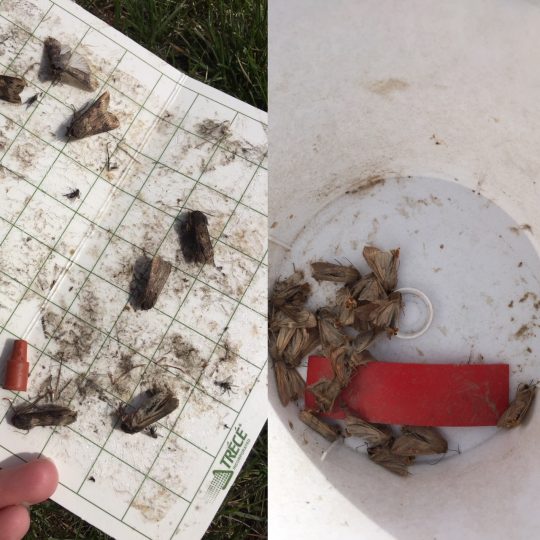Black Cutworm Moth Flight Beginning
Soil temperatures and field activity are increasing along with moth migration from the south. Insect traps (figure 1) are out around the state and we’ve been capturing both true armyworm and black cutworm moths for over a week. In fact, we recently had our first significant black cutworm moth flights recorded in Montgomery and Champaign counties (figure 2). We expect activity to increase with both of these insects over the coming weeks. As both corn and soybean planting progress, we encourage growers to scout emerging fields for the present of insect injury.

For more complete information about the biology, life cycle, and management of black cutworms, a fact sheet is available from the Department of Crop Sciences, UIUC. Provided below is a brief overview of some key life cycle and management facts concerning black cutworms.
- Black cutworm moths are strong migratory insects with northward flights commonly observed from Gulf States into the Midwest from March through May.
- Moths are attracted to fields heavily infested with weeds such as henbit, chickweed, shepherd’s purse, peppergrass, and yellow rocket. Cover crops are also attractive to both armyworm and cutworm.
- Late tillage and planting tends to increase the susceptibility of fields to black cutworm infestations.
- Cutting of corn plants begins when larvae reach the 4th instar — with a single cutworm cutting an average of 3 to 4 plants during its larval development.
- Cutting tends to occur most often during nights or on dark overcast days.
- Fields at greatest risk to cutting and economic damage are in the 1-to-4 leaf stage of plant development.
- An early warning sign of potential economic damage includes small pinhole feeding injury in leaves (caused by the first 3 instars).
- Producers are encouraged to look for early signs of leaf feeding as a potential indicator of cutting, rather than waiting for cutting to take place.
- Don’t assume that all Bt hybrids offer the same level of cutworm protection. Plants in the 1- to 4-leaf stage are most susceptible to cutting.
- Cutting of plants earlier than these projected cutting dates is possible — localized intense flights may have occurred and were not picked up by our volunteers.
- A nominal threshold of 3% cutting of plants has traditionally been used as a point at which growers should consider a rescue treatment.

Figure 1. Projected potential cutting dates, April 23, 2018. - Not all Bt hybrids offer adequate protection against black cutworm damage. Growers should consult the Handy Bt trait table prepared by Dr. Chris DiFonzo at Michigan State University to determine the level of protection provided by their chosen Bt hybrid.
Continue to look for insect updates and weekly trap counts here in the Bulletin along with updates via Facebook and Twitter.





